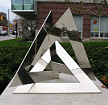 |
THE
FIELDS INSTITUTE FOR RESEARCH IN MATHEMATICAL SCIENCES
|
Inverse
Problems and Image Analysis Seminar
July 2013 - June 2014
Hosted
by the Fields Institute
Organizers:
Abdol-Reza Mansouri (Queen's U)
Adrian Nachman (U of Toronto)
|
 |
|
|
Upcoming Seminars
|
Tuesday June 24 at 2pm
Stewart Library
|
John Sylvester, University of Washington
The Inverse Source Problem
The inverse source problem for the Helmholtz equation seeks
to recover information about a source from remote observations
of its radiated field. This is a linear inverse problem,
but the existence of non-radiating sources means that we
must accommodate the non-uniqueness inherent in the problem.
I will explain why it is theoretically possible to distinguish
between "well-separated" sources (distance between
supports strictly greater than diameters) and describe recent
work exploring the well-posedness of "distinguishing"
fields radiated by well-separated sources. Just as in inverse
scattering, the restricted Fourier transform, and how it
transforms with respect to translations and rotations plays
a major role.
|
| Past Seminars
|
Thursday, May 29, 10:30-12:00
BA 6183 |
Professor Mats Gustafsson
Lund University, Sweden
Near-field Diagnostics of Antennas and Radomes
Visualization of electromagnetic fields and currents facilitates
our understanding of the interaction between the fields
and devices. This is easily done in numerical simulations
where the electromagnetic fields can be calculated. It is
very difficult in most measurement situations where the
fields cannot be measured directly but must instead be reconstructed
from measurements of the fields outside the region of interest.
This reconstruction requires the solution of an inverse
source problem. Reconstructions of field and current distributions
are useful in applications such as non-destructive diagnostics
of antennas and radomes and assessment of specific absorption
ration (SAR) in the body due to base station radiation.
In this presentation, we show how the field and current
distribution can be reconstructed and visualized from near-
and far-field measurement data. We illustrate how they can
be used in antenna and radome diagnostics to, for example,
identify faulty components. We discuss recent developments
in inverse source problems to accurately reconstruct electromagnetic
fields on a surface or volume from near- and far-field measurements.
We review the theory for inverse source problems, non-uniqueness,
and regularization. We present formulations based on equivalent
currents using integral equations and integral representations
for planar, spherical, body of revolution, and general geometries.
|
|
Thursday Jan. 23
1:30 p.m.
Room 230
|
Martin Bauer, University of Vienna
Riemannian Geometry of Shape Spaces
I will provide an overview of various notions of shape
spaces, including the space of parametrized and unparametrized
surfaces. I will discuss the Riemannian metrics that can
be defined thereon, and what is known about the properties
of these metrics. I will put particular emphasis on the
induced geodesic distance, the geodesic equation and its
well-posedness, geodesic and metric completeness and properties
of the curvature. In addition I will present selected numerical
examples illustrating the behavior of these metrics.
|
Nov. 14, 2013
2:10 pm
** in Huron 1018** |
Klas Modin, University of Toronto and Chalmers University
of Technology, Göteborg, Sweden
Diffeomorphic Image Registration
In this informal talk, I will present the framework of
"large deformation diffeomorphic metric matching".
This framework is used for non-rigid registration of grey-scale
images. I will focus on the underlying Riemannian geometry
and the connection to fluid mechanics through Euler-Arnold
equations.
|
|
Thursday July 18
2:00 p.m.
Stewart Library
|
Sung Ha Kang, Georgia Institute of Technoogy
Variational and RKHS Approach for Image Colorization and
Segmentation
This talk will start with an introduction to image restoration,
starting from Total Variation minimizing denoising, and
consider inpainting and colorization problems. The term
``colorization'' was introduced by Wilson Markle who first
processed the gray scale moon image from the Apollo missions.
A couple of variational colorization models will be presented
which demonstrate different effects. Another appeoach that
uses a Reproducing Kernel Hilbert Space method will be presented
for an effective colorization application. A link to image
segmentation will be made through a medical image application.
Image segmentation separates the image into different regions
to simplify the image and identify the objects easily. The
Mumford-Shah and Chan-Vese models are some of the most well-known
variational models in the field. If time permits, this talk
will include a model segmenting piecewise constant images
with irregular object boundaries, and consider some features
of multiphase segmentation.
|
|
|
|
back to top
|
 |